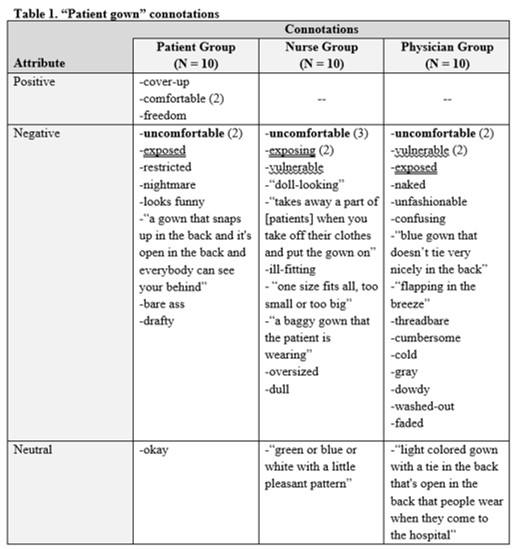Background: Although the intended purpose of the hospital gown is not to cause harm, it reinforces the role of being subordinate to the physician. Gowns put patients in a vulnerable position because they can be readily exposed all day. The identical, interchangeable patient gown reinforces the role of the lowly patient in the hospital hierarchy, negating identity and promoting a “sick” role for the patient. The purpose of this study was to explore how patients and providers perceive the need for and the impact of wearing hospital gowns.
Methods: Patients (N=10; 5 women, 5 men), physicians (N=10; 6 women, 4 men), and nurses (N=10; 9 women, 1 man) from Hershey Medical Center participated in qualitative interviews with a list of questions, e.g. “When I say patient gown, what is the first thought or word that comes to mind?”, and probing when necessary. Transcripts were analyzed for common themes.
Results: The most common words associated with “patient gown” were uncomfortable, exposing, and vulnerable (Table 1). Patients were the only group to state positive connotations. The providers seemed to be more bothered by the psychological impact of the hospital gown on the patient than the patients themselves. The most common requests for improvements to hospital-provided patient attire were separates (e.g., pants and a shirt or shorts and a shirt) and designing the back of the gown to prevent exposure of a patient’s backside. However, cost was cited by nurses (60%) and physicians (80%) as the greatest barrier to quality improvement.
Conclusions: Past studies have identified clothing worn in care environments as a means to improve patient care. Poignant remarks from this study highlight the need for improved hospital attire, including: “Don’t let the gown get you down,” advice from a 26-year-old cancer patient; “When you’ve been here as much as I have, you don’t have a self-esteem,” spoken by a 67-year-old-man after a 53 day admission; and, “You lose your dignity anyway when you go to the hospital…You need to remember, I actually had a life, I didn’t always look like this,” wisdom from a 64-year-old with terminal cancer. Still, cost and improving bottom lines persist as barriers to improved patient gowns, which come, or are perceived to come, with increased cost. One way to reconcile cost with increased patient satisfaction would be to encourage patients to wear their own clothes whenever possible. However, there will always be instances when patients cannot safely wear their own clothes, necessitating a gown. Therefore, it is imperative that more research be done, gathering data from patients and providers to redesign hospital gowns and enhance both patient and provider experiences.

